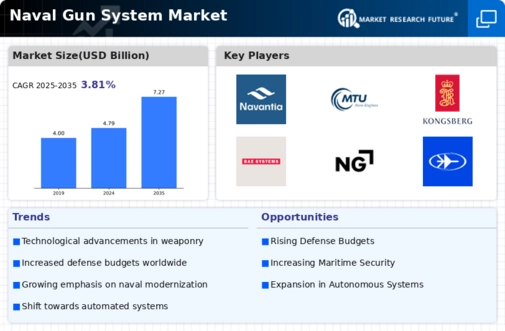Top Industry Leaders in the Naval Gun System Market

Strategies Adopted: In the fiercely competitive Naval Gun System market, key players deploy strategic approaches to maintain a competitive edge. Continuous investment in research and development (R&D) is crucial, allowing companies to introduce next-generation naval gun systems with enhanced range, precision, and multi-role capabilities. Strategic collaborations with naval forces, international partnerships, and alliances facilitate technology transfer and ensure the development of specialized naval gun systems tailored to specific naval operational needs. Global market expansion through participation in naval contracts, international sales, and establishing production facilities in key regions ensures a broad market reach, allowing companies to address the diverse requirements of naval forces worldwide.
Competitive Landscape of Naval Gun System Market
- BAE Systems plc (UK)
- Lockheed Martin Corporation (US)
- Raytheon Company (US)
- Saab AB (Sweden)
- Thales Group (France)
- General Dynamics Corporation (US)
- Kratos Defense & Security Solutions
- (US)
- Israel Military Industries (Israel)
- L-3 Technologies Inc. (US)
- Northrop Grumman Corporation (US)
- PIT-RADWAR S.A. (Poland)
- Bohemia Interactive Simulations (US)
- Meggitt PLC (UK)
- Boeing (US)
- Israel Aerospace Industries (Israel)
Factors for Market Share Analysis: Market share analysis in the Naval Gun System market involves considering various factors crucial to a company's competitive standing. Technical capabilities, such as the ability to offer a comprehensive range of naval gun systems covering different calibers and functionalities, play a pivotal role. Companies providing adaptable and modular naval gun solutions capable of addressing diverse threats, from anti-air warfare to naval surface fire support, are better positioned to capture a larger market share. Compliance with stringent naval standards, accuracy, and integration of advanced technologies, such as automation and fire control systems, contribute significantly to market share dynamics. Additionally, factors like life-cycle support, maintenance services, and overall cost-effectiveness influence a company's market share by enhancing the overall value proposition for naval customers.
New and Emerging Companies: While established players dominate the market, new and emerging companies are making strides in the Naval Gun System sector. Companies like Elbit Systems and DSIT Solutions are gaining recognition for their specialized naval gun solutions, often focusing on advanced fire control systems, stealth capabilities, and integration with naval sensor networks. Emerging companies often bring agility and innovative perspectives to the Naval Gun System market, introducing novel approaches and technologies that address the evolving needs of modern naval warfare.
Industry News: Recent industry news in the Naval Gun System market highlights ongoing developments and trends shaping the sector. Innovations in naval gun automation, advanced materials for barrel construction, and precision-guided munitions for naval artillery are gaining prominence. News often covers advancements in stealth technologies for naval gun systems, improving survivability and reducing detectability. Additionally, developments in naval gun integration with broader naval combat systems, enhancing situational awareness and targeting capabilities, underscore the industry's commitment to staying ahead of emerging threats and technological advancements. Industry news reflects the dynamic nature of the Naval Gun System market, with continuous efforts to improve firepower, accuracy, and overall naval operational capabilities.
Current Company Investment Trends: Investment trends in the Naval Gun System market underscore a commitment to technological innovation, modularity, and global reach. Companies are allocating substantial resources to R&D initiatives focused on advanced gun barrel materials, automation, and smart munitions. Investments in digitalization and connectivity for naval gun systems, ensuring seamless integration with naval networks, align with the defense industry's broader push towards network-centric warfare. Strategic acquisitions of technology startups, partnerships with naval research institutions, and collaborations with international defense contractors contribute to a comprehensive approach, ensuring a continuous stream of cutting-edge solutions and maintaining a competitive stance in the market.
Overall Competitive Scenario: The overall competitive scenario in the Naval Gun System market reflects a balance between established industry leaders and emerging companies that bring innovation and flexibility to the sector. Established defense contractors and naval weapon manufacturers leverage their extensive experience, global reach, and comprehensive naval gun portfolios to set industry standards. Simultaneously, emerging companies contribute to the diversification of Naval Gun System solutions, often focusing on specific applications or introducing disruptive technologies. The industry's response to evolving naval requirements, technological advancements, and the integration of advanced features into naval gun systems highlights the adaptability and resilience of Naval Gun System providers. As naval forces globally seek more advanced and versatile naval gun solutions, the Naval Gun System market is poised for continued evolution. The emphasis on technological advancements, strategic collaborations, and meeting the dynamic needs of modern naval warfare positions this market as a critical enabler for naval superiority in maritime defense operations.
Recent Development:
- Countries, including the United States, China, and Russia, are actively pursuing the development of hypersonic missiles, which can achieve speeds of Mach 5 or higher, rendering them highly challenging to intercept.
- Parallel to this, nations like the United States, China, and Russia are engaged in the advancement of directed energy weapons, including lasers and microwaves. These weapons show great potential in effectively targeting naval assets.
- Another trend in naval technology is the growing prevalence of unmanned naval systems. Unmanned Underwater Vehicles (UUVs) and Unmanned Surface Vehicles (USVs) are increasingly utilized for diverse tasks, such as minesweeping, intelligence gathering, and electronic warfare.


